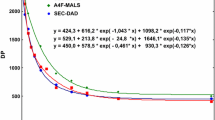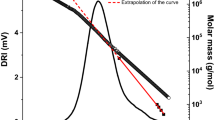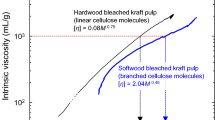Abstract
The study focuses on the comparison of the results obtained by size exclusion chromatography (SEC) detection systems using multiangle laser light scattering (MALLS) and/or ultraviolet–visible (UV/VIS) detectors in analyses of cellulose in paper-based heritage objects. The commonly applied parameter for the evaluation of paper degradation stage and kinetics is weight (M w ) average molar mass measured by SEC. The main problems addressed here are whether the parameters obtained by various techniques and calibration strategies and in various laboratories can be treated universally and what the sources of the discrepancies can be. The SEC-UV/VIS technique proved to give reproducible results as demonstrated by the interlaboratory correlations. Using various data processing methods and SEC techniques it was also shown that molar masses should only be treated relatively. The differences between the kinetic curves based on the M w values obtained from various techniques and processed with various calibration procedures question the reliability of kinetic equations derived using the SEC results to describe the paper degradation.






Similar content being viewed by others
Abbreviations
- A 2 :
-
Second virial coefficient in Rayleigh equation—solvent–solute interactions
- α :
-
Scattering angle
- c :
-
Concentration of a polymer, mg cm−3
- D :
-
Degree of polymerization
- (η):
-
Intrinsic viscosity, cm3 g−1
- k :
-
Rate constant in Ekestam equation, s−1
- K :
-
Optical constant in Rayleigh equation
- K, a :
-
Mark–Houwink-Sekurada (MHS) coefficients in Eq. 1 describing the relation between intrinsic viscosity of a polymer solution (η) and its molar mass M
- λ 0 :
-
Vacuum wavelength of incident beam, nm
- M(GCT):
-
Molar mass of anhydrous glucopyranose triscarbanilate unit, 519 g mol−1
- M :
-
Molar mass of a polymer, g mol−1
- M n :
-
Number average molar mass, g mol−1
- M v :
-
Viscosity average molar mass, g mol−1
- M w :
-
Weight average molar mass, g mol−1
- n 0 :
-
Refractive index of a solvent
- N A :
-
Avogadro’s number
- dn/dc :
-
Refractive index increment
- <r 2 >:
-
Mean square radius of the molecule
- P(α):
-
Form factor in Rayleigh equation—scattered light dependence on angle
- R(α):
-
Excess Rayleigh ratio—the difference between Rayleigh ratio for a solution and a pure solvent
- t :
-
Degradation time, days
- t el :
-
Time of elution, min
- V el :
-
Elution volume, cm3
- w :
-
Fraction of molar mass M of a polymer
References
Andersson M, Wittgren B, Wahlund KG (2003) Accuracy in multiangle light scattering measurements for molar mass and radius estimations model calculations and experiments. Anal Chem 75:4279–4291
Barański A, Łagan JM, Łojewski T (2005) Acid-catalysed degradation. In: Strlič M, Kolar J (eds) Aging and stabilisation of paper, University of Ljubljana, Ljubljana, pp 93–110
Barański A, Begin P, Łagan JM, Łojewski T, Sawoszczuk T (2006) Application of the Zou Uesaka and Gurnagul model to the degradation of papers of various origins. J Pulp Paper Sci 32:238–244
Barkalow DG, Rowell RM, Young RA (1989) A New approach for the production of cellulose acetate: acetylation of mechanical pulp with subsequent isolation of cellulose acetate by differential solubility. J Appl Polym Sci 37:1009–1018
Berek D, Kubin M, Morcinka K, Dressler M (1989) Chromatografia żelowa. PWN, Warszawa
Beuermann S, Buback M, Davis TP, Gilbert RG, Hutchinson RA, Kajiwara A, Klumperman B, Russell GT (2000) Critically evaluated rate coefficients for free-radical polymerization. Macromol Chem Phys 201:1355–1364
Daňhelka J, Kössler I (1976) Determination of molecular weight distribution of cellulose by conversion into tricarbanilate and fractionation. J Polym Sci 14:287–298
Demeter J, Mormann W, Schmidt J, Burchard W (2003) Solution behaviour of trimethylsilyl cellulose of different degrees of substitution studied by static and dynamic light scattering. Macromolecules 36:5297–5303
Dupont AL (2003a) Cellulose in lithium chloride/NN–dimethylacetamide optimization of a dissolution method using paper substrates and stability of solutions. Polymer 44:4117–4126
Dupont AL (2003b) Gelatine sizing of paper and its impact on the degradation of cellulose during aging—a study using SEC, dissertation, Amsterdam
Dupont AL, Mortha G (2004) Comparative evaluation of size exclusion chromatography and viscometry for the characterization of cellulose. J Chromat A 1026:129–141
Emsley AM, Stevens GC (1994) Kinetics and mechanism of the low-temperature degradation of cellulose. Cellulose 1:26–56
Evans R, Wearne R, Wallis AFA (1989) Molecular weight distribution of cellulose as its tricarbanilate by high performance size exclusion chromatography. J Appl Polym Sci 37:821–827
Evans R, Wearne R, Wallis AFA (1991) Pyridine catalyzed depolymerization of cellulose during carbanilation with phenylisocyanate in dimethylsulfoxide. J Appl Polym Sci 42:3291–3303
Fellers C, Iversen T. et al (1989) Ageing/degradation of paper, a literature survey, FoU-projectet for Papperkonservering Report 1E. ISSN 0284-5636
Girod S, Baldet-Dupy P, Maillols H, Devoisselle JM (2001) On-line direct determination of the second virial coefficient of a natural polysaccharide using size-exclusion chromatography and multi-angle laser light scattering. J Chromat A 943:147–152
Grubisic Z, Rempp P, Benoit H (1996) A universal calibration for gel permeation chromatography (Reprinted from Polymer Letters vol 5 pg 753–759 1967). J Polym Sci B Polym Phys 34:1707–1713
Guillaneuf Y, Castignolles P (2008) Using apparent molecular weight from SEC in controlled/living polimerization and kinetics of polymerization. J Polym Sci A 46:897–911
Havermans JBGA (1995) Environmental influences on the deterioration of paper. Meeuwes & Co, Delft, Rotterdam, Barjesteh
Hill DJT, Le TT, Darveniza M, Saha T (1995) A study of degradation of cellulosic insulation materials in power transformer part 1 molecular weight study of cellulose insulation paper. Polym Degrad Stab 48:79–87
Hon DN, Shiraishi N (2000) Wood and cellulosic chemistry. Marcel Dekker, New York
Jerosch H, Lavédrine B, Cherton C (2001) Study of the stability of cellulose–holocellulose solutions in NN-dimethylacetamide–lithium chloride by size exclusion chromatography. J Chromatogr A 927:31–38
Karlsson O, Westermark U (1996) Evidence for chemical bonds between lignin and cellulose in kraft pulps. J Pulp Paper Sci 22:J397–J401
Kato KL, Cameron RE (1999) Structure-property relationships in thermally aged cellulose fibers and paper. Appl Polym Sci 74:1465–1477
Kennedy JF, Rivera ZS, White CA, Lloyd LL, Warner FP (1990) Molecular-weight characterization of underivatized cellulose by GPC using lithium chloride-dimethylacethamide solvent system. Cellulose Chem Technol 24:319–325
Kolar J, Balažic A, Strlič M, Kočar D (2006) Micro-destructive evaluation of paper degradation. Extended abstracts: Belonging to the oral and poster presentations of the final MIP conference [and] 2nd International iron gall ink meeting, 24–27 Jan 2006, Newcastle upon Tyne, UK, 87–89
Kostanski LK, Keller DM, Hamielec AE (2004) Size-exclusion chromatography—a review of calibration methodologies. J Biochem Biophys Meth 58:159–186
Lauriol JM, Comtat J, Froment P, Pla F, Robert A (1987a) Molecular weight distribution of cellulose by on-line size exclusion chromatography—low angle laser light scattering; Part II: acid and enzymatic hydrolysis. Holzforschung 41:165–169
Lauriol JM, Froment P, Pla F, Robert A (1987b) Molecular weight distribution of cellulose by on-line size exclusion chromatography—low angle laser light scattering; Part I: basic experiments and treatment of data. Holzforschung 41:109–113
Łojewska J, Lubańska A, Łojewski T, Miśkowiec P, Proniewicz LM (2005) Kinetic approach to degradation of paper in situ ftir transmission studies on hydrolysis and oxidation. e-Preservation Sci 2:1–12
Łojewski T, Miśkowiec T, Missori M, Lubańska A, Proniewicz LM, Łojewska J (2010a) FTIR and UV/vis as methods for evaluation of oxidative degradation of model paper: DFT approach for carbonyl vibrations. Carb Polym 82:370–375
Łojewski T, Zięba K, Knapik A, Bagniuk J, Lubańska A, Łojewska J (2010b) Evaluating paper degradation progress cross-linking between chromatographic spectroscopic and chemical results. Appl Physics A 100:809–821
Łojewski T, Zięba K, Łojewska J (2010c) SEC-MALLS in paper degradation studies. New Mark-Houwink coefficients for cellulose in CED. J Chromat A 1217:6462–6468
Malešič J, Kolar J, Strlič M, Kocar D, Fromageot D, Lemaire J, Haillant O (2005) Photo–induced degradation of cellulose. Polym Degrad Stab 89:64–69
Marcelo G, Saiz E, Tarazona MP (2007) Determination of molecular parameters of hydroxyethyl and hydroxypropyl celluloses by chromatography with dual detection. J Chromat A 1165:45–51
Mori S, Barth HG (1999) Size exclusion chromatography. Springer, Heidelberg
Pffeferkorn P, Beister J, Hild A, Thielking H, Kulicke WM (2003) Determination of the molar mass and the radius of gyration together with their distributions for methylhydroxyethylcelluloses. Cellulose 10:27–36
Porsch B, Anderson M, Wittgren B, Wahlund KG (2002) Molecular mass distribution analysis of ethyl(hydroxyethyl) cellulose by size–exclusion chromatography with dual light–scattering and refractometric detection. J Chromat A 964:69–81
Ritter A, Schmid M, Affolter S (2010) Determination of molecular weights by size exclusion chromatography (SEC)–Results of round robin tests. Polym Test 29:945–952
SCAN-CM 15:88 (1988) Viscosity in cupri-ethylenediamine solution, standard scandinavian Pulp Paper and Board Testing Committee
STEP project CT 90-0100 (1994) The effects of air pollutants on the accelerated ageing of cellulose containing materials—paper. Final project report, TNO Delft
Stol R, Pedersoli JL Jr, Poppe H, Kok WT (2002) Application of SEC to the microanalitycal determination of the molecular mass distribution of celluloses from the objects of cultural and historical value. Anal Chem 74:2314–2320
Strlič M, Kolar J (2003) Size exclusion chromatography of cellulose in LiCl/NN–dimethylacetamide–Review. J Biochem Biophys Methods 56:265–279
Strlič M, Kolar J, Zigon M, Pihlar B (1998) Evaluation of size exclusion chromatography and viscometry for the determination of molar masses of oxidized cellulose. J Chromat A 805:93–99
Strlič M, Kolar J, Kolenc J, Pihlar B (2002) Enthalpic interactions in size exclusion chromatography of pullulan and cellulose in LiCl–N N–dimethylacetamide. J Chromat A 964:47–54
Strlič M, Kolar J, Kočar D, Rychlý J (2005a) Thermo-oxidative degradation. In: Strlič M, Kolar J (eds) Aging and stabilisation of paper, University of Ljubljana, Ljubljana, pp 111–132
Strlič M, Kolar J, Pihlar B (2005b) Methodology and analytical techniques in paper stability studies. In: Strlič M, Kolar J (eds) Aging and stabilisation of paper, University of Ljubljana, Ljubljana, pp 27–47
Strlič M, Kolar J, Scholten S (2005c) Paper and durability. In: Strlič M, Kolar J (eds) Aging and stabilisation of paper, University of Ljubljana, Ljubljana, pp 3–8
Sundholm F, Tahvanainen M (2003) Preparation of cellulose samples for size-exclusion chromatography analyses in studies of paper degradation. J Chromat A 108:129–134
Zięba K (2009) Size exclusion chromatography as a tool to study paper and cellulose degradation in conservation chemistry, dissertation. Jagiellonian University
Acknowledgments
The funds from the Project SPB 811/N-COST/2010/0 of the Polish Ministry of Science and Higher Education is kindly acknowledged. The interlaboratory comparison was based on the results obtained during PaperTreat project (No. SSPI-006584) supported by the European Commission under the 6th FP. We gratefully acknowledge Dr. Jana Kolar for kind permission for use in this work the results obtained in National and University Library in Ljubljana.
Author information
Authors and Affiliations
Corresponding author
Rights and permissions
About this article
Cite this article
Łojewski, T., Zięba, K., Kołodziej, A. et al. Following cellulose depolymerization in paper: comparison of size exclusion chromatography techniques. Cellulose 18, 1349–1363 (2011). https://doi.org/10.1007/s10570-011-9562-7
Received:
Accepted:
Published:
Issue Date:
DOI: https://doi.org/10.1007/s10570-011-9562-7




